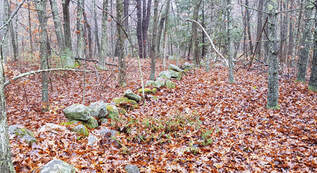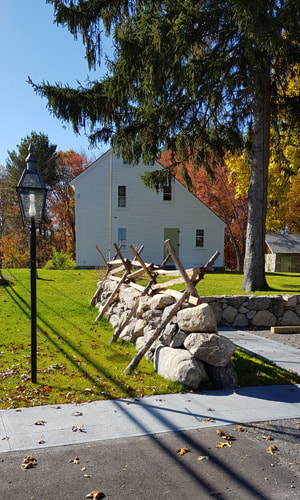|
11/16/2019 What's Wrong with Our Stone Walls? One of New England’s familiar sights is a stone wall in a forest, a remnant of land use in days gone by. Based on what we can see, many of us assume that farmers would have removed the many rocks from their fields and stacked them in two- to three-foot-high walls to delineate their property from their neighbors’ or to serve as a barrier to animals. The former landscape that we envision would have been open fields and gardens surrounded, if not by wooden fencing, by relatively low stone walls. Most of us today have had no experiences to challenge that view. Visitors to our recently refurbished landscape are surprised to discover that above our stone walls at the Hosmer House are crossed, wooden poles. Why would we ruin the look of “iconic” stone walls? As it turns out, while our imagined Massachusetts farm landscape is not entirely fictitious, farmers often supplemented their rock walls with wood to make enclosures higher and less likely to let animals escape. According to Robert Thorson’s Stone by Stone, a hybrid fence of stone on the bottom and wood on the top was very common. The stone walls, in many cases, were “linear landfills” to give farmers somewhere to put the rocks cluttering their fields, and the wood raised the height of the fences to the 3.5-5 feet considered necessary to block the movement of animals. Farmer’s wooden fence extensions have, of course, rotted away, so we have no way of knowing which of the many stone walls in Acton would have been built up with wood. It is quite possible that Jonathan and Simon Hosmer and those who came after them on our property built mixed, high walls to keep in their livestock. The Society’s new walls are a reminder that we need to keep our minds open to learn more about the lives of Acton’s former residents. Even commonly-held ideas of how things were in earlier days may simply reflect the fact that our frame of reference is very different from theirs. Comments are closed.
|
Acton Historical Society
Discoveries, stories, and a few mysteries from our society's archives. CategoriesAll Acton Town History Arts Business & Industry Family History Items In Collection Military & Veteran Photographs Recreation & Clubs Schools |
Quick Links
|
Open Hours
Jenks Library:
Please contact us for an appointment or to ask your research questions. Hosmer House Museum: Open for special events. |
Contact
|
Copyright © 2024 Acton Historical Society, All Rights Reserved

 RSS Feed
RSS Feed